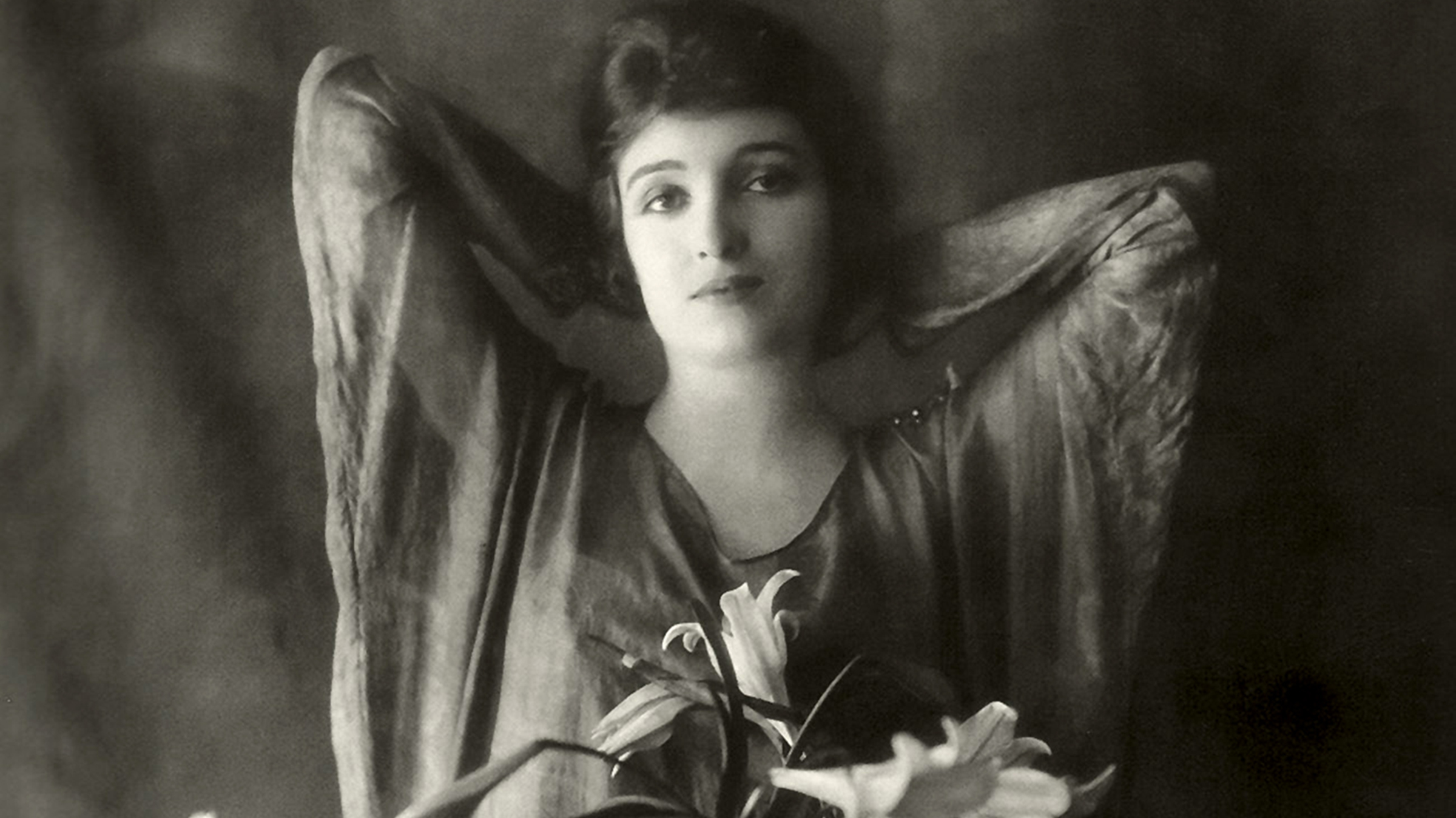This feature was presented in conjunction with the screening of Dancing Mothers at SFSFF 2024
“I haven’t enjoyed myself so much in years as I have recently, grandly rejecting parts,” Alice Joyce declared in 1924. After marrying the affluent James Regan Jr., Joyce could choose her roles carefully. Informed by more than a decade of screen experience and a keen self-awareness, Joyce’s selections were, as Anthony Slide notes, “remarkably intelligent,” reflecting her insight and finesse as an actor.
Gentlewomen in Jeopardy
In two of her best remembered pictures, Joyce portrays Englishwomen trapped by painful dilemmas. Amid the Orientalist hokum of The Green Goddess, Joyce grounds extreme situations with understated credibility, yet still delivers the juicy pleasures we crave from far-fetched melodrama. Much of the film’s suspense derives from tense interplay between Joyce as Lucilla and a beturbaned George Arliss as the Rajah, who presents a cruel choice to her: succumb to his advances or die. During one engrossing scene, Lucilla’s dignified wariness collapses when the Rajah offers to reunite her with her children. But then hope hardens into resolve and contempt for his manipulations. She gathers herself for a sublime refusal and makes a grand exit.
Joyce balances Beau Geste’s conspicuous theme of masculine devotion with some feminine strength. Watching Lady Patricia preside over a happy household, the audience, like Beau, cannot help but condone, even admire, her secret sale of a purloined sapphire. She embodies the caring determination that holds families together. The last reel depends on Joyce to convey both the dear price and the glory of Beau’s sacrifice. As Lady Patricia reads his final letter, we can almost hear the throb in her voice. In the closing shot, her faraway gaze transfigures grief into spiritual uplift.
Beyond Motherhood
Joyce’s off-screen status as a high-society mother shaped her public image, as researcher Greta de Groat has noted. However, the star’s more daring characterizations on-screen defy the notion that motherhood defines a woman’s identity. Ethel Westcourt flouts convention in Dancing Mothers by charting her own course instead of settling for a selfish family. At the beginning of The Home Maker, Joyce commits to a fearlessly unlikeable portrait of domestic dissatisfaction. As Eva Knapp scrubs floors and disciplines her unruly youngest child, her hard, glaring eyes and the bitter set of her mouth reveal her contagious misery. Later, finding fulfillment as a breadwinner, she carries herself with relaxed assurance and is able to repair her homelife.
Joyce also explored the sorrows of working mothers. Edith in Daddy’s Gone A-Hunting supports herself and her daughter so that her husband can paint abroad, but he tramples on her love by returning a callous bohemian. Under the direction of Frank Borzage, whom Joyce praised for coaching natural performances, she goes from bruised dismay to tearful despair to shocked humiliation, all with an affecting poignancy. When we first see journalist Phyllis Dale in Headlines, she’s at ease in a bustling newsroom. Her eyes fixed on her typewriter, she grabs a cigarette, then searches for a match, as if she had done so a thousand times. Though comfortable in her career, Phyllis fears her fiancé will shift his affections to her teenage daughter. Her insecurity captures a realist’s recognition of her diminishing social value as she ages.
Compassionate Ladies
Whether playing a blueblood or a commoner, Joyce excelled at suggesting innate nobility. Tempted though the viewer may be to resent the patrician Helen Morrison in Stella Dallas, Joyce imbues the second Mrs. Dallas with kindness and tact. In Sorrell and Son, compassionate housekeeper Fanny Garland helps sustain the overburdened Sorrell, steadfast father of the title, with her discreet but enduring affection.
Sometimes Joyce reveals her characters’ warmth through the artful use of her hands. As Mrs. Morrison, she tenderly lays her hands over Stella Dallas’s clasped fingers, highlighting a kinship between mothers that transcends class barriers. When Mrs. Morrison invites the young Laurel to live with her, Joyce takes the girl’s hand in both of her own, enfolding the step-daughter in a mother’s love with an elegant gesture. Sensing the hero’s troubles in Sorrell and Son, Fanny lets her hand slide down his forearm. The movement, casually done but ripe with meaning, signifies a union worthy of, though not formalized by, marriage.
Grande Dames with a Twist
Joyce proved adept at putting a comic twist on her aristocratic poise. In So’s Your Old Man, Princess Lescaboura elevates W.C. Fields’s Mr. Bisbee from persona non grata to local bigwig. A repeated joke arises from a friendly misunderstanding: Bisbee continues to believe that his benefactress is a charlatan. When he congratulates her on the deceit, Joyce’s wink and smile communicate their jovial bond. This princess relishes the conspiracy, though she really has nothing to hide. Besides, she is too well-bred to embarrass him with the truth.
At the opposite end of the snob spectrum, Mrs. De Peyster of 13 Washington Square leads with a formidable hauteur that renders her misadventures all the more delicious. Wielding the Social Register like a Bible, Mrs. De Peyster attempts to thwart her son’s elopement with a grocer’s daughter. Her schemes precipitate a series of inconveniences and perils, as well as an unlikely rapport with a burglar that prompts the grande dame to reevaluate her convictions. Like the sun emerging from behind a cloud, Joyce’s radiance after her character’s change of heart makes us believe that the events of a single night could melt this mighty ice queen.

